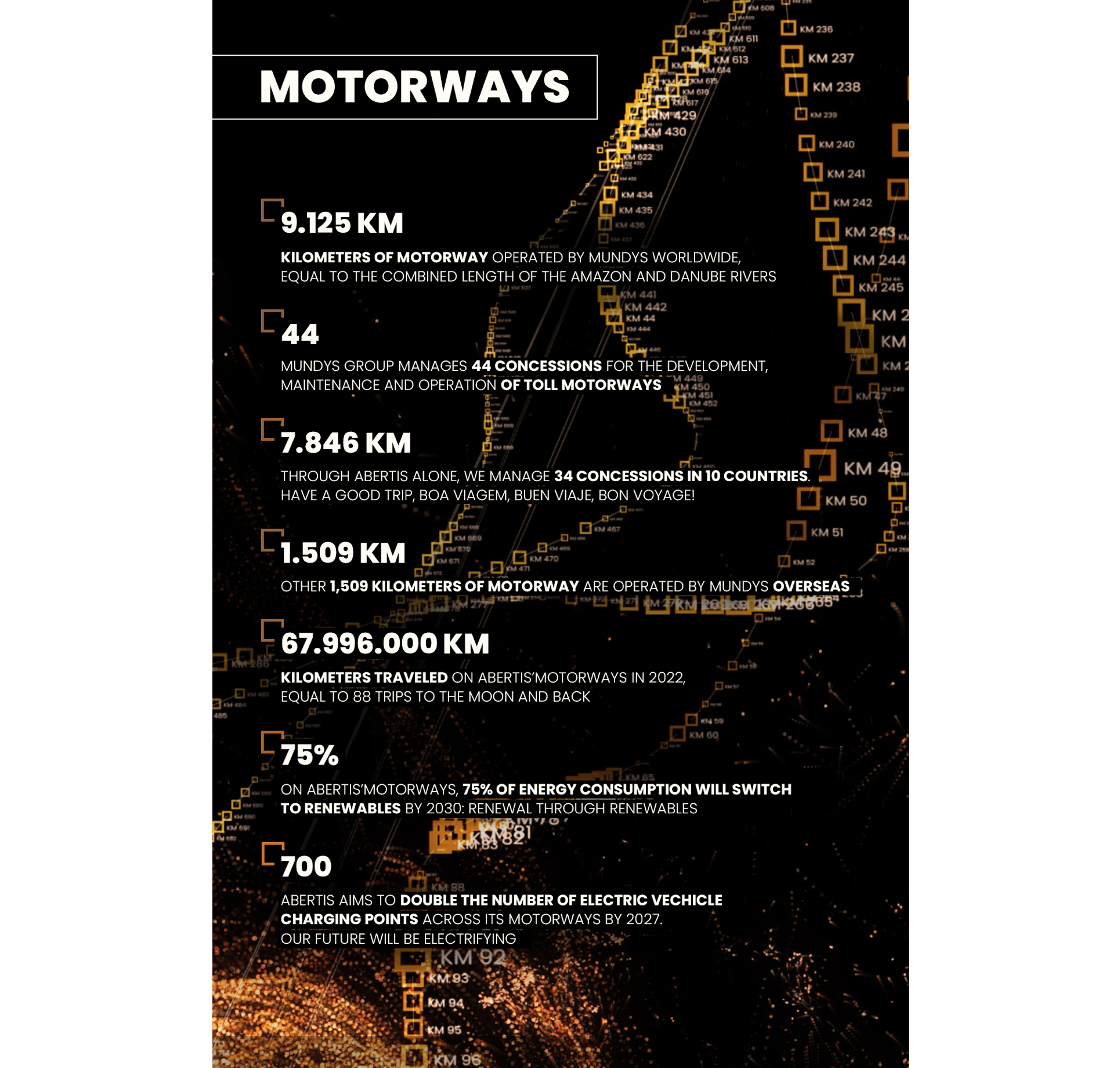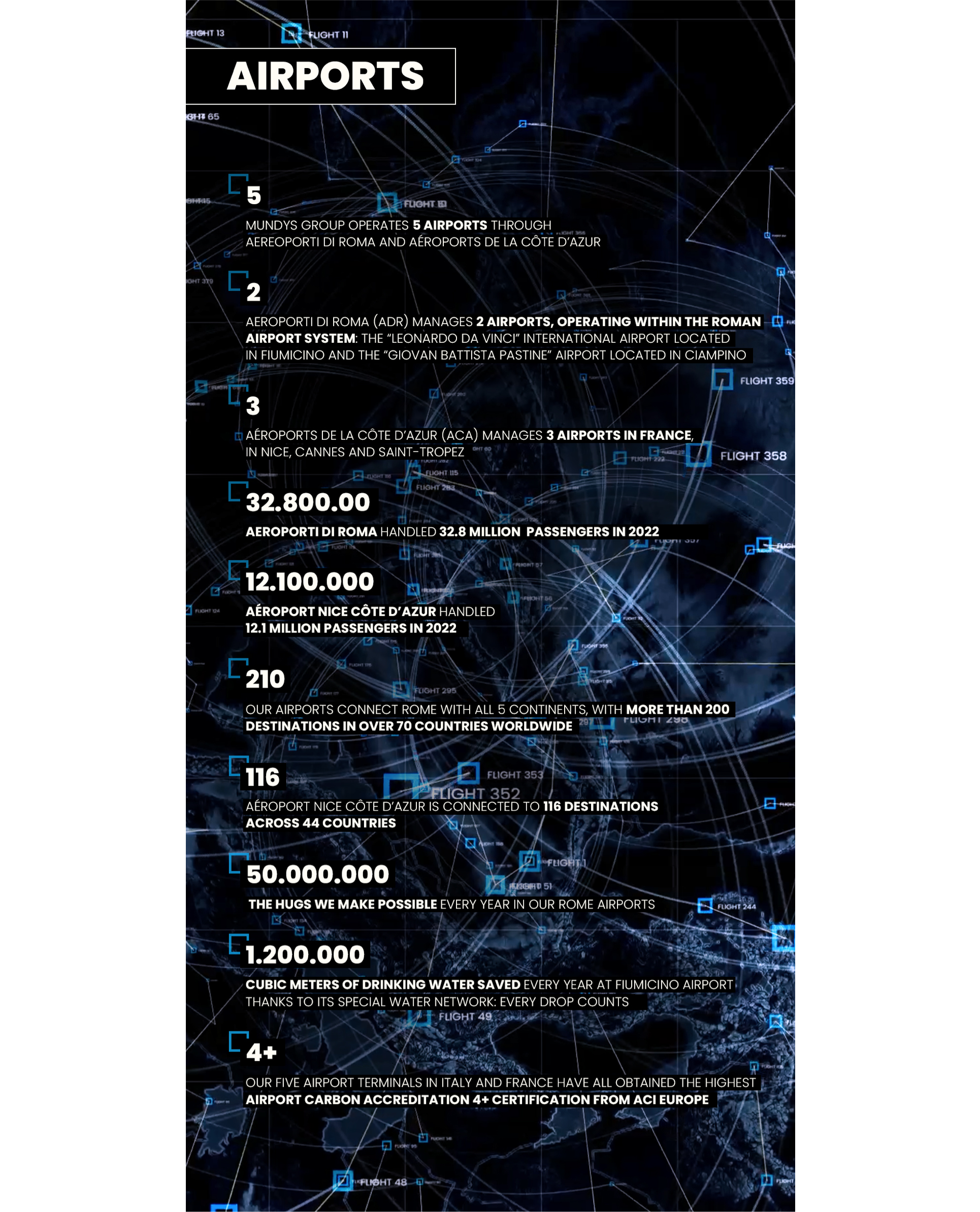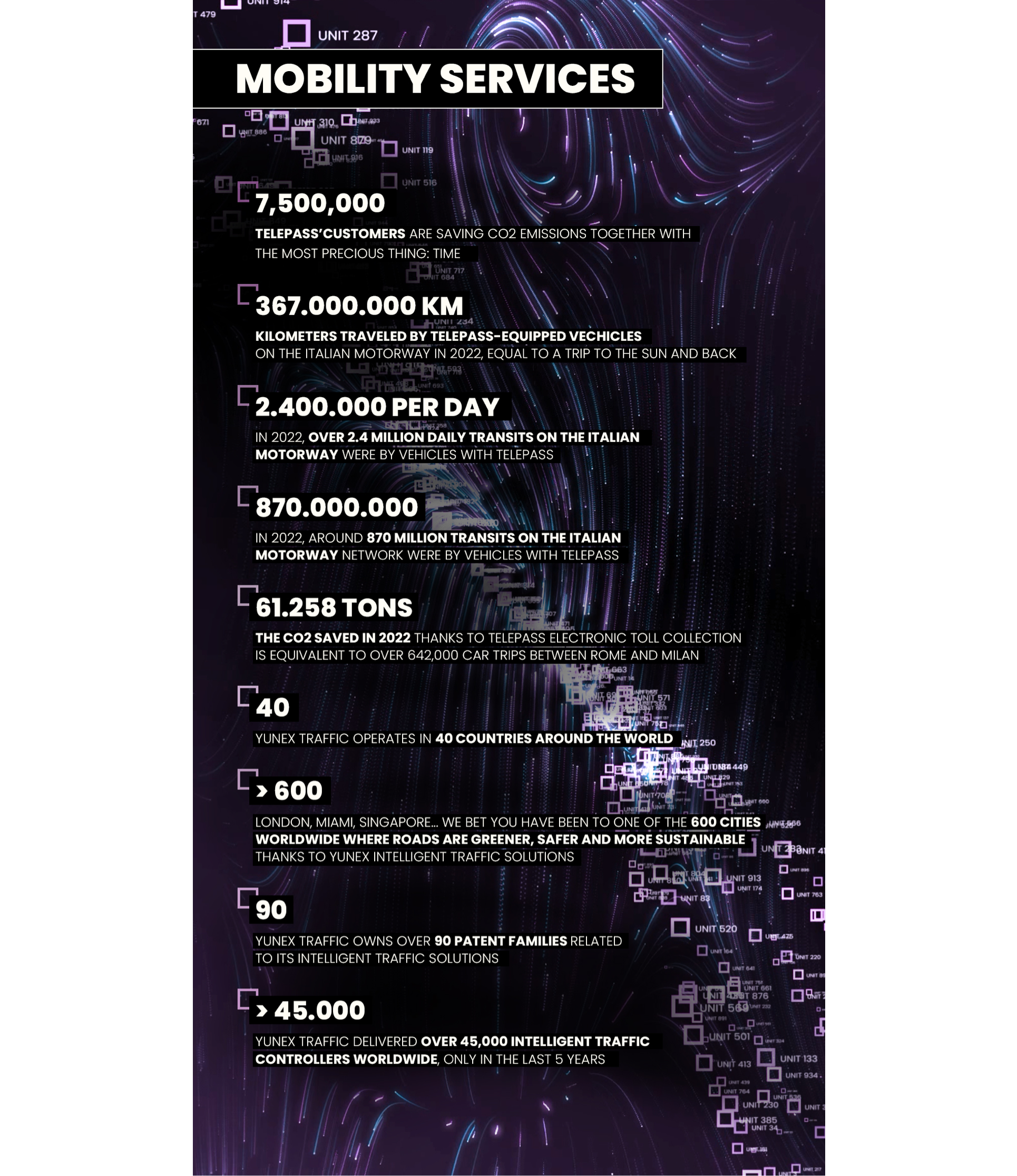Moving Data
We are a global leader in sustainable integrated mobility services. We are with you along your travels in four continents with our infrastructures and services. Each year, we handle 3 billion light and heavy vehicle journeys over more than 9.000 kilometers of motorway, we welcome 45 million passengers in 5 airports and we provide our mobility services in 23 countries worldwide.
We are Mundys, our commitment is to improve moving life by offering the opportunity to travel in an increasingly sustainable, safe, innovative and efficient way.
We are Mundys, our commitment is to improve moving life by offering the opportunity to travel in an increasingly sustainable, safe, innovative and efficient way.
What is Moving Data?
Moving Data is an installation that takes visitors on a journey inside the Mundys’s universe through four thematic paths: Sustainability, Motorways, Airports, and Mobility Services, i.e., the four pillars of the Group.
Moving Data is a Data Art project signed by Media.Monks Milan in collaboration with WOA Creative Company. The artwork is the perfect fusion between the innovation that Mundys brings forward in the field of mobility and the creative ability of Media.Monks Milan. Thanks to the work of artist Davide Asker, and his team WOA Creative Company, the data related to each of the pillars come to life and are transformed into evocative visual worlds for passengers, which are the users of the work and the center of Mundys's purpose. With Moving Data the artist wants to offer an engaging and dynamic look at the innovations and solutions deployed by Mundys to improve the daily travel experience of passengers and travelers.
Moving Data represents the ideal balance between creativity and technology and succeeds in creating a dreamlike and relaxing space in a chaotic and busy place like the airport. The mirrored structure of the installation, conceived and designed by WOA Creative Company, gives the illusion of being in an infinite space where those who enter the artwork can fully immerse themselves and be part of it. The four massive LED monitors placed at the inner corners of the structure, and the 85 light fixtures allow those who enter to interact with the visuals, thanks to LiDAR scanner technology that detects users' movements, thus creating an immersive experience where sound and light synchronize to respond to visitors' actions.
Moving Data is a Data Art project signed by Media.Monks Milan in collaboration with WOA Creative Company. The artwork is the perfect fusion between the innovation that Mundys brings forward in the field of mobility and the creative ability of Media.Monks Milan. Thanks to the work of artist Davide Asker, and his team WOA Creative Company, the data related to each of the pillars come to life and are transformed into evocative visual worlds for passengers, which are the users of the work and the center of Mundys's purpose. With Moving Data the artist wants to offer an engaging and dynamic look at the innovations and solutions deployed by Mundys to improve the daily travel experience of passengers and travelers.
Moving Data represents the ideal balance between creativity and technology and succeeds in creating a dreamlike and relaxing space in a chaotic and busy place like the airport. The mirrored structure of the installation, conceived and designed by WOA Creative Company, gives the illusion of being in an infinite space where those who enter the artwork can fully immerse themselves and be part of it. The four massive LED monitors placed at the inner corners of the structure, and the 85 light fixtures allow those who enter to interact with the visuals, thanks to LiDAR scanner technology that detects users' movements, thus creating an immersive experience where sound and light synchronize to respond to visitors' actions.
Explore the four pillars of “Moving Data”
At Mundys, sustainability means contributing to the development of increasingly green, safe, smart and efficient mobility solutions to meet people’s primary need to move around, whilst at the same time enabling the creation of economic and social value for the communities and areas in which the Company operates, alongside financial returns.
In carrying out our activities, our approach is based around the United Nations Global Compact’s 10 Principles, as well as to the Sustainable Development Goals (SDGs) of the 2030 Agenda and to the objectives of the Paris Agreement on climate change.
We are aware that the transport sector is one of the largest sources of greenhouse gas (GHG) emissions. Thus, we adopted our Climate Action Plan, which consists of a multi-year program of initiatives to achieve zero direct emissions (Scope 1 & 2) by 2040 for the Group.
Our Climate Action Plan is based on specific actions that we have been carrying out to achieve our targets.
In carrying out our activities, our approach is based around the United Nations Global Compact’s 10 Principles, as well as to the Sustainable Development Goals (SDGs) of the 2030 Agenda and to the objectives of the Paris Agreement on climate change.
We are aware that the transport sector is one of the largest sources of greenhouse gas (GHG) emissions. Thus, we adopted our Climate Action Plan, which consists of a multi-year program of initiatives to achieve zero direct emissions (Scope 1 & 2) by 2040 for the Group.
Our Climate Action Plan is based on specific actions that we have been carrying out to achieve our targets.
-50%
By 2030 we aim to reduce by 50% our 2019 direct emissions, which accounted for approximately 245,000 tons of CO2e. About 57% are related to emissions from fossil fuel for stationary and mobile sources and 43% are related to electricity and thermal energy consumption to operate our assets.In 2022, direct emissions (Scope 1 & 2) across Mundys Group fell by 26% compared to 2019 to around 182.500 tons of CO2e.

77%
A fundamental milestone to achieve the reduction of direct emissions is represented by renewable energy consumption. We aim to increase electricity consumption from renewable sources to 77% within 2030.In 2022, our consumption of renewable electricity rose significantly, totalling 66% of total electricity consumption (in 2019 it reached 15%).
Our goal is 100% of electricity consumption from renewable sources by 2040.

Besides cutting our direct emissions, we commit also to reduce indirect emissions (Scope 3) along the whole value chain, so we are eager to play an active role in teaming up with stakeholders to engage in joint efforts to decarbonize the transport industry.
Motorways
We aim at reducing indirect emissions related to purchased materials mainly associated with road infrastructure development, maintenance and operation, gradually shifting to materials with lower life cycle emissions and promoting circular economy.
Airports
We are eager to partner with other stakeholders along the value chain to reduce emissions related to the accessibility of passengers at the airports as well as emissions due to the consumption of aircrafts during take-off and landing phases.
Motorways
We aim at reducing indirect emissions related to purchased materials mainly associated with road infrastructure development, maintenance and operation, gradually shifting to materials with lower life cycle emissions and promoting circular economy.
-22%
In 2019 (still in a pre-Covid-19 scenario) the physical intensity of those emissions was 7.9 tons of CO2e per million of kilometers travelled on our motorways. Our goal is to reduce this intensity by 22% within 2030, versus a 2019 baseline.Airports
We are eager to partner with other stakeholders along the value chain to reduce emissions related to the accessibility of passengers at the airports as well as emissions due to the consumption of aircrafts during take-off and landing phases.
60%
We work alongside airlines to set reduction plans in line with the Paris Agreement for at least 60% of emissions generated from aircraft takeoff and landing.-30%
In 2019 emissions related to passengers getting to Fiumicino airport (through various means of transport) were 14.3 kilograms of CO2e per passenger. By 2030, our goal is to reduce those emissions by 30%.
Business Partners
-50%
We are committed to collaborate with companies in which Mundys has a minority stake so that these companies reduce by 50% CO2 emissions under their direct control, by 2030.Our emissions reduction targets within 2030 has been recently approved by the Science Based Target Initiative (SBTi), a partnership between CDP (former Carbon Disclosure Project), the United Nations Global Compact, World Resources Institute (WRI) and the World Wide Fund for Nature (WWF) that defines and promotes best practice in science-based target setting and independently assesses companies’ targets.
This validation by SBTi comes as a recognition of our targets being aligned with a 1.5°C pathway for containing global warming and with the trajectory set by the Paris Agreement on climate change
LEARN MORE ABOUT THE SCIENCE BASED TARGET INITIATIVE ON THEIR WEBSITE
This validation by SBTi comes as a recognition of our targets being aligned with a 1.5°C pathway for containing global warming and with the trajectory set by the Paris Agreement on climate change
LEARN MORE ABOUT THE SCIENCE BASED TARGET INITIATIVE ON THEIR WEBSITE
Our decarbonization targets require changing our own processes and activities.
With regards to direct emissions (Scope 1 & 2) we will keep:
On the other hand, with regards to indirect emissions (Scope 3), we want to contribute to the decarbonization of the sector, through:
With regards to direct emissions (Scope 1 & 2) we will keep:
- Increasing the consumption of electricity from renewable sources, aiming at the procurement of 100% high-quality certified green energy in key markets;
- Improving energy efficiency in lighting, buildings and infrastructure management;
- Boosting photovoltaic power production, by installing plants across our motorway network and constructing power production farms within our airports premises in Italy and France;
- Replacing and improving of heating/conditioning systems;
- Migrating our fleet to hybrid and electric vehicles.
On the other hand, with regards to indirect emissions (Scope 3), we want to contribute to the decarbonization of the sector, through:
- the promotion of the circularity of processes through the reuse and recycling of materials;
- procurement of goods and services with lower life cycle emissions;
- the promotion of energy transition of the transport industry; for instance by installing over 700 charging points for electric vehicles along Abertis’ motorway network within 2027, and by deploying over 5.400 charging points by 2031, servicing passengers and the entire airport eco-system;
- the improvement of rail accessibility to the airport terminal, with an increase in the number of trains and a decrease in tariffs;
- the development of initiatives to raise awareness among airport operators for the supply of certified green energy and the use of low-emission vehicles.
We are the first provider in the world of toll-roads management. We combine research for new technological and digital solutions with traditional technical and engineering skills, to develop an efficient mobility ecosystem that is increasingly oriented towards sustainability.
Through Abertis group and other companies we manage 44 concessions for the development, maintenance and operation of toll motorways in 11 countries across Europe, America and Asia.
We are currently investing in the upgrade of our motorway networks and the introduction of new services and technologies to better serve people on the move. Here are some examples:
• To enable the spread and use of environmentally friendly vehicles, by the end of 2022 Abertis had installed more than 390 charging points (EVCPs), out of a total of more than 700 planned by 2027;
• In France, the new “free flow” technology without toll barriers or booths, resulting in significant improvements in traffic flow and cuts in emissions, is due to enter service from 2024 on 220 kilometers of motorway;
• In Chile, through Grupo Costanera we are developing a plan designed to improve the quality of life for approximately 2 million inhabitants living in the southern part of Santiago. This will include the creation of new community and green spaces, as well as the introduction of systems that will improve urban safety and the installation of over 16 kilometers of noise barriers.
Through Abertis group and other companies we manage 44 concessions for the development, maintenance and operation of toll motorways in 11 countries across Europe, America and Asia.
We are currently investing in the upgrade of our motorway networks and the introduction of new services and technologies to better serve people on the move. Here are some examples:
• To enable the spread and use of environmentally friendly vehicles, by the end of 2022 Abertis had installed more than 390 charging points (EVCPs), out of a total of more than 700 planned by 2027;
• In France, the new “free flow” technology without toll barriers or booths, resulting in significant improvements in traffic flow and cuts in emissions, is due to enter service from 2024 on 220 kilometers of motorway;
• In Chile, through Grupo Costanera we are developing a plan designed to improve the quality of life for approximately 2 million inhabitants living in the southern part of Santiago. This will include the creation of new community and green spaces, as well as the introduction of systems that will improve urban safety and the installation of over 16 kilometers of noise barriers.

Aeroporti di Roma operates within the Roman airport system, consisting of Fiumicino and Ciampino airports. it is the number one airport operator in Italy by number of passengers. In the last six years, the international “Leonardo da Vinci” airport in Fiumicino was awarded five times with the Europe Best Airport award, in 2023 it has also been certified as a 5-Star airport for quality of service by Skytrax.
Aéroports de la Côte d’Azur is France’s second most important airport hub, and it manages three airports located in Nice, Cannes and Saint-Tropez.
All of our airports in Italy and France achieved the highest level of Airport Carbon Accreditation (Level 4+ Transition) and they are committed to a decarbonization strategy in order to deliver our Scope 1 and Scope 2 net-zero ambition.
Only few airports received such level of accreditation worldwide, five of them are part of Mundys, making our Group one of the global leaders in airport sustainability.
We will be keep focusing on the construction of sustainable and innovative airport infrastructure, the development of intermodality and the deployment of technologies that will make an effective contribution to the sector’s decarbonization.
Aéroports de la Côte d’Azur is France’s second most important airport hub, and it manages three airports located in Nice, Cannes and Saint-Tropez.
All of our airports in Italy and France achieved the highest level of Airport Carbon Accreditation (Level 4+ Transition) and they are committed to a decarbonization strategy in order to deliver our Scope 1 and Scope 2 net-zero ambition.
Only few airports received such level of accreditation worldwide, five of them are part of Mundys, making our Group one of the global leaders in airport sustainability.
We will be keep focusing on the construction of sustainable and innovative airport infrastructure, the development of intermodality and the deployment of technologies that will make an effective contribution to the sector’s decarbonization.

Telepass provides sustainable, integrated mobility services: it is responsible for operating electronic tolling systems in Italy and 13 European countries and transport-related payment systems (car parks, restricted traffic zones, vehicle tracking systems, etc.), promoting an integrated and “seamless” approach to mobility. Also, it also provides digital mobility, insurance and breakdown services.
Yunex Traffic is the global leader in ITS (Intelligent Transport Systems), whose infrastructure and platforms for managing traffic flow and urban mobility are used in more than 600 cities (including London, Singapore, Miami and Bogotà) and across 4 continents.
The majority of CO2 emissions from transport are produced by road transport and, at the same time, congestion in the world’s major cities has increased. This situation is due to worsen in the future: according to industry estimates, by 2050, almost 70% of the world’s population will live in large cities, compared with 55% in 2018 and 60% by 2031.
Yunex Traffic’s mission is to develop, install and operate artificial intelligence and smart traffic management systems designed with the aim of cutting emissions. Cities such as Birmingham and Manchester, where Yunex Traffic is present, have reduced emissions by 30% and 15%, respectively, in the first 6 months.

